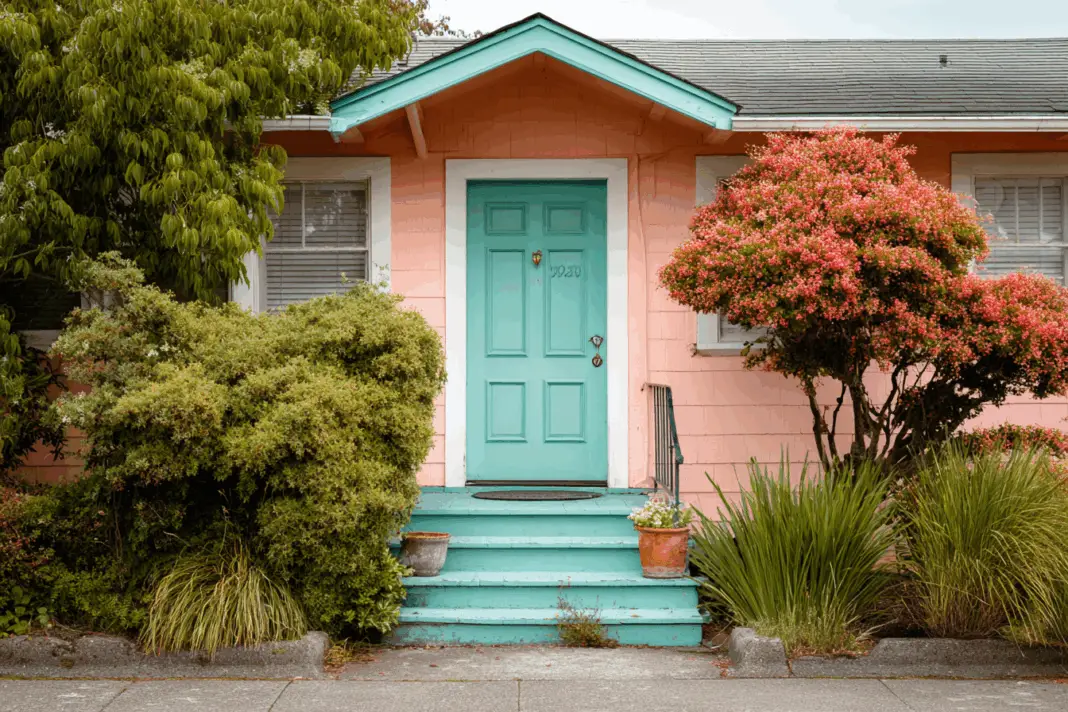Walking up to a house with a front door painted in electric orange feels like approaching a traffic cone rather than someone’s welcoming home. The color choices homeowners make for their front doors can either boost their property’s charm or send visitors running in the opposite direction. Professional designers have strong opinions about which hues work and which ones absolutely don’t, based on years of witnessing both stunning successes and complete disasters.
Neon colors make your home look like a circus
Bright neon shades might seem fun and energetic, but they create the wrong kind of attention for your home’s entrance. Electric blue, shocking pink, lime green, and traffic cone orange grab every neighbor’s eye for all the wrong reasons. These colors don’t just stand out – they scream for attention in a way that makes your entire house look unbalanced and chaotic. The intensity of neon hues overwhelms other architectural elements and makes it impossible for visitors to focus on anything else about your home’s exterior.
Professional designers consistently steer clients away from these attention-grabbing shades because they clash with virtually every exterior material and color scheme. Design experts explain that neon colors are “pretty much always too different and stand out in the wrong ways.” The vibrant intensity makes your home look more like a commercial building or novelty attraction rather than a welcoming residence that potential buyers or guests would find appealing.
Pure white doors show every speck of dirt
White front doors might seem like a safe, classic choice, but they create more problems than most homeowners anticipate. Every fingerprint, scuff mark, muddy paw print, and weather stain becomes glaringly obvious against a bright white surface. Rain, snow, and everyday use quickly turn that crisp, clean appearance into a dingy, neglected-looking mess that requires constant maintenance and frequent touch-ups to keep looking presentable.
Beyond the maintenance nightmare, pure white doors often lack the visual impact needed to create an impressive entrance. Design professionals describe white doors as appearing “plain” and missing “a major statement-making opportunity.” The color typically fails to provide enough contrast against lighter exterior materials, making the entire facade look flat and uninspiring rather than welcoming and sophisticated.
Pastel shades lack visual weight and presence
Soft pastels like baby pink, powder blue, and pale lavender might look charming in a paint store, but they disappear when applied to actual front doors. These delicate shades lack the visual weight needed to create a proper focal point for your home’s entrance. Instead of drawing the eye and creating interest, pastel doors tend to blend into the background, making your house look incomplete or unfinished from the street.
The problem becomes even worse when pastel doors are paired with traditional exterior materials like brick, stone, or wood siding. Interior designers note that these “muddy pastels like dusty lilac or pale mint green” often “appear faded or underwhelming,” particularly when surrounded by richer, more substantial building materials. The mismatch creates an awkward contrast that makes the entire exterior look poorly planned and executed.
Bright yellow creates school bus associations
Yellow front doors often trigger immediate associations with school buses, taxi cabs, or caution signs rather than creating the warm, welcoming atmosphere most homeowners want. Primary yellow is particularly problematic because its intensity and brightness feel jarring against most residential architecture. The color demands attention in a way that feels aggressive rather than inviting, making guests feel like they’re approaching a commercial building rather than someone’s home.
Even when homeowners choose yellow hoping to create a cheerful, sunny entrance, the result often backfires spectacularly. Design professionals warn that yellow “will definitely make your home’s front door stand out, but probably not in the way you want,” describing it as a shade that makes homes “feel a little less polished.” The color’s associations with warning signs and commercial vehicles are so strong that they overpower any positive, welcoming message the homeowner intended to convey.
Dark colors cause serious structural damage
Black and deep navy doors might look sophisticated in photos, but they create serious practical problems that can damage your door and cost money to repair. Dark colors absorb significantly more heat from sunlight than lighter shades, causing the door material to expand and contract more dramatically with temperature changes. This constant movement leads to warping, cracking, and splitting that ruins the door’s appearance and compromises its function as a barrier against weather.
The heat absorption problem becomes especially severe during summer months when dark doors can become too hot to touch comfortably. Design experts explain that these “darker shades tend to absorb heat, causing the door to swell and shrink, which can lead to splits, cracks, or warping.” The structural damage often requires expensive door replacement or professional repairs that far exceed the cost of simply choosing a more practical color from the beginning.
Orange doors feel hostile and unwelcoming
Orange front doors create an immediate sense of aggression that pushes visitors away rather than welcoming them inside. The color’s intensity and warmth become overwhelming when applied to such a prominent architectural feature, making the entrance feel hostile rather than inviting. Most people instinctively associate bright orange with warning signs, construction equipment, and emergency vehicles, creating subconscious feelings of caution or danger when approaching the door.
The coordination challenges with orange make it nearly impossible to create a cohesive, attractive exterior design. Professional designers describe traffic cone orange as color that “overwhelms the whole façade and nearly shouts, ‘Get out!’ when it should be saying, ‘Come on in.'” The shade clashes with virtually every common exterior material including brick, stone, vinyl siding, and wood, making the entire house look poorly planned and visually chaotic.
Purple doors clash with architectural styles
Purple front doors rarely work well with traditional American architectural styles, creating an awkward mismatch that makes homes look confused and poorly designed. The color feels too bold and unconventional for classic styles like Colonial, Tudor, or Craftsman homes, where it clashes with the established design principles and historical authenticity. Even modern homes struggle with purple doors because the color’s intensity can overwhelm clean, minimalist lines and neutral color palettes.
The rarity of successful purple door installations speaks to how difficult this color is to execute properly in residential settings. Design professionals note that “only in very few cases have pro designers been able to pull off a purple front door,” whether in muted or vivid shades. The color represents such a “massive departure from materials and hues used in certain architectural styles” that it almost always looks forced and out of place rather than intentional and welcoming.
Cool grays appear cold and uninviting
Cool gray and steely blue doors create an emotional distance that makes homes feel unwelcoming and institutional rather than warm and inviting. These colors work well in modern commercial buildings or sleek urban condos, but they feel completely wrong when applied to residential front doors surrounded by natural materials. The coldness of these shades creates a barrier between the home and its visitors, suggesting that people should keep their distance rather than feel welcome to approach and enter.
The problem becomes especially pronounced when cool grays are paired with warmer architectural elements that are common in residential construction. Design professionals explain that while these colors “might work in sleek, modern interiors, on a front door they can feel aloof or out of sync with warmer architectural elements like brick, wood, or natural stone.” The mismatch creates visual tension that makes the entire exterior look poorly coordinated and unwelcoming to guests and potential buyers.
Muddy brown tones look dated and boring
Mid-tone and muddy brown front doors create one of the most uninspiring entrances possible, making homes look dated and neglected rather than well-maintained and welcoming. These dull brown shades often blend so completely with common exterior materials like brick, wood siding, or stone that the door essentially disappears, leaving the entrance without any focal point or visual interest. The result is a facade that looks incomplete and poorly designed.
The association between muddy brown doors and outdated design trends makes these colors particularly problematic for homeowners concerned about curb appeal and property values. Design experts describe certain brown tones as looking “like dried dirt” and bringing “zero curb appeal” to residential exteriors. When potential buyers or guests see a muddy brown door, they often assume the interior design will be equally outdated and uninspiring, creating negative first impressions that are difficult to overcome.
Choosing the right front door color requires balancing personal style with practical considerations and broader design principles that create lasting appeal. The colors that consistently fail do so because they either create maintenance problems, clash with architectural elements, or send the wrong emotional message to visitors and potential buyers. Smart homeowners invest time in selecting door colors that enhance their home’s natural beauty while avoiding the costly mistakes that reduce curb appeal and property values.

